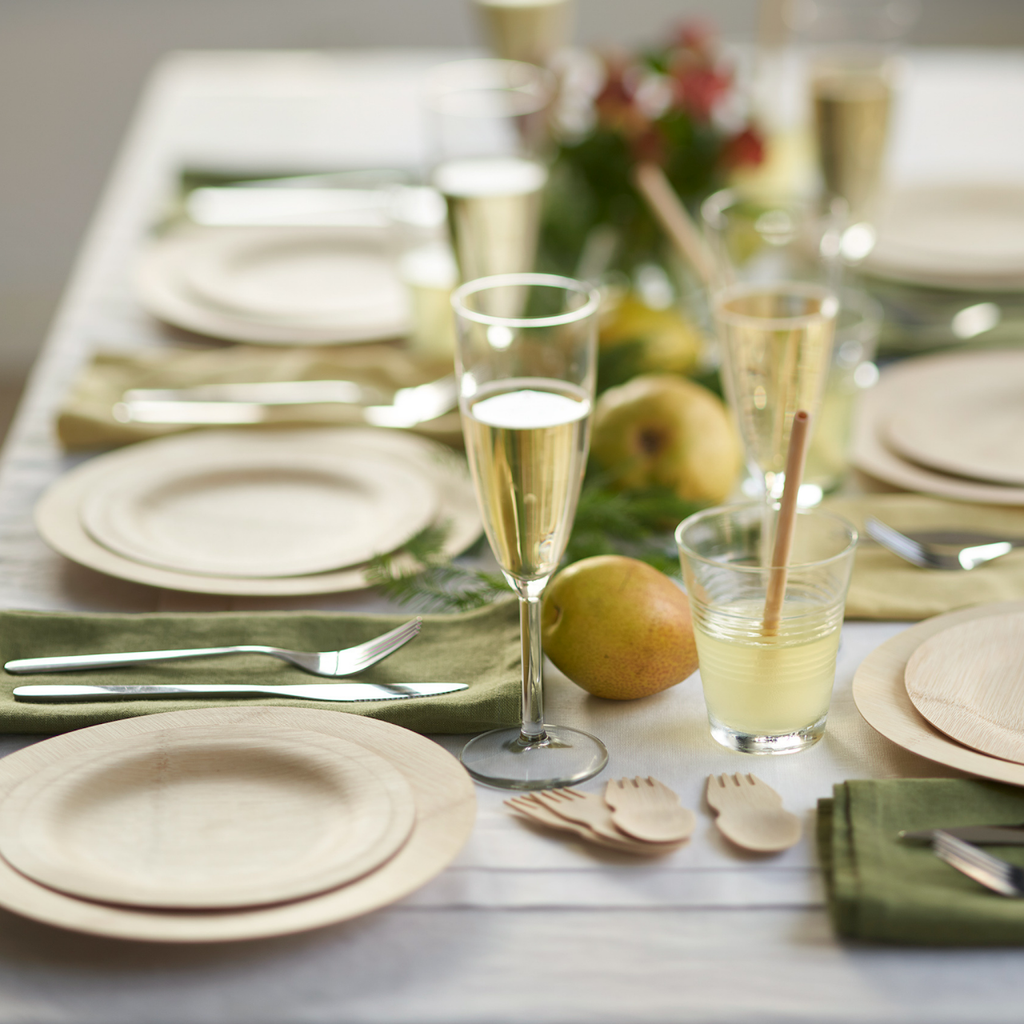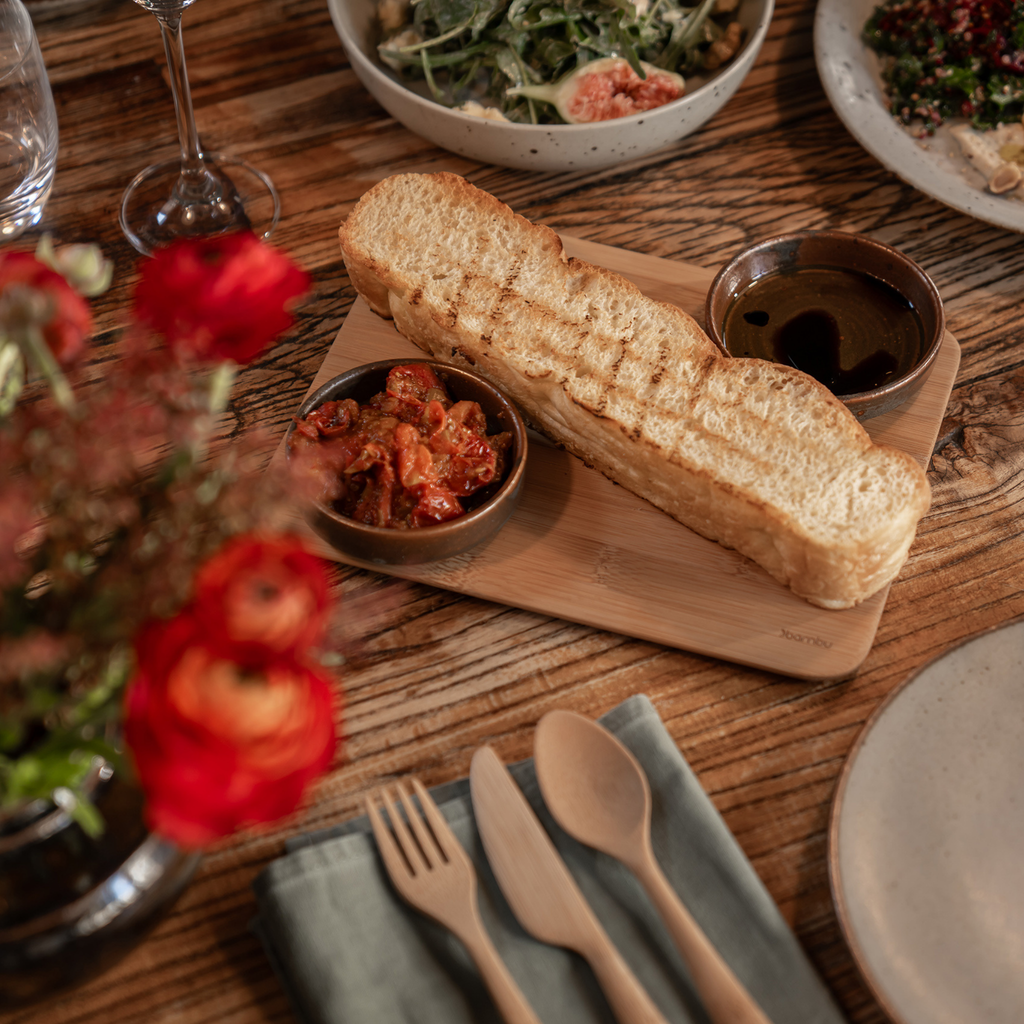Instead of a product ending up in the trash at the “end” of its life, what if it gained a second (and third) life as something new? As we search for ways to move towards a sustainable future for all, the circular economy model might just be the key to leaving the “use once and throw away” mentality behind for good.

Since Bambu® first opened its doors nearly 20 years ago, thinking long-term has been a priority. Our founders began designing products with the thought that there is no “away.” Once a product is made, and eventually disposed of, it won’t simply disappear. So a product’s life, from start to finish, must be mapped out to create the lowest impact possible. At Bambu, that means designing daily use products that hold up through years of day in, day out use. And, planning for a product’s entire life cycle by using renewable materials that can be composted or will biodegrade at the end of their life.
However, not all businesses think this way. In fact, most don’t. As a result, two-thirds of all materials moving through the world’s economy end up in landfills. This unsustainable economic model is ripe for re-thinking, which is where the concept of circular economy comes into play.
What Is a Circular Economy?
The circular economy system is rooted in a goal to eliminate waste from the production process. This way of thinking goes beyond relying solely on recycling as a way to keep items out of landfills and focuses on preventing waste before it’s created.
While recycling aims to reclaim some value from items that were destined to be thrown away, circular economy principles start at the beginning of a product’s life cycle. Rather than designing an item for a single use and then disposing of it, a circular economy focuses on using renewable materials and designing products so that there is no waste in their life cycle. Items made from materials that are biodegradable (like bamboo) are perfectly suited for a circular economy.
Sound familiar? It should - because the natural world around us already operates this way. In nature, there are no landfills, and there is no waste. For example, when plants die, they decompose into nutrient-rich soil that feeds new plants what they need to grow and thrive. This is the type of thinking that the circular economy model is based on. Here’s how it works:
Eliminate Waste
First and foremost, a circular system reduces and eventually completely eliminates waste and pollution. By getting rid of waste from the start, there’s no need to “clean up” after the fact. This saves energy and resources. And it starts with using clean manufacturing processes that don’t harm the earth. Ideally, renewable energy sources are used, and energy is used as efficiently as possible.
Keep In Use Longer
Producing anything, no matter how sustainably uses resources and energy. So items designed for a circular economy are made to last. With thoughtful design, engineering and craftsmanship, items we use every day can last for years to come. Keeping products in use longer reduces the amount that we need to produce. This is central to preserving resources and reducing waste.
Circulate Materials
Next, a circular system uses materials that can be recycled, refurbished, repurposed, or safely decompose (more on the last part later). The goal is to keep materials in circulation so that they are constantly being used, and no waste is created in the production process.
Regenerate Nature
The final building block of a circular economy is to regenerate nature. Instead of ending up in landfills, natural materials end their lives by returning to the soil. This adds nutrients back into natural systems that keep them healthy and growing. And eventually, allows for the generation of more materials. Thus, the cycle of a circular economy can go on (and on).
Thinking Outside The Line: Circular Economy Sustainability vs. Linear Economy
Right now, most products are created in a linear fashion. In short, a linear economy looks like this: Take, Make, Use, Dispose. Materials are extracted, used to create an item, and then the item is disposed of once its “use” is all used up. The problem? Once a non-renewable material is extracted, it’s gone for good. And once an item is no longer useful, it sits in the trash for years and years. Thinking long-term, this linear model just won’t work. And with the amount of trash that’s produced every day, recycling alone will never be enough to combat the amount of waste that a linear economy produces.
The circular economy is naturally regenerative. Items made circularly can cycle through the process again and again. And at the end of the day, the natural world is better (not worse) because of this process.
How Biobased Products Fit Into a Circular Economy
Launched in 2002, the USDA Biobased program was created to support and create growth for biobased products. Biobased products are made from natural, plant-based materials. Usually, they offer a natural alternative to petroleum-based products, like plastic.
Because they’re made from natural, renewable materials, biobased products are already designed with circular thinking in mind. Creating with renewable materials like bamboo means that waste is nearly eliminated and that natural ecosystems aren’t harmed by involved extraction processes or harsh chemicals. With thoughtful design, the amount of material used to create each product can be drastically reduced, too. Using excess material to craft smaller products, as we do with the Bambu® Spork, is a simple way to design for circularity. At the end of the day, materials are used as efficiently as possible, and waste is lessened from the start of a product’s life.
But, no matter how well-designed, a product will always meet its end-of-life. Some Biobased products are also compostable, which is perhaps the best end-of-life that a product made for a circular economy can have. When properly disposed of, compostable products decompose back into the soil. This process regenerates the earth with the nutrients it needs to produce more renewable materials.
Today, it’s easier than ever to find Biobased products, with over 3,000 companies offering Biobased products. Bambu is proud to be recognized as a pioneering member of the USDA Biobased program, and one of its first 50 members. Now, every product we offer is Biobased certified.

The Bottom Line: Designing Products For Their End-of-Life
Because there is no “away” a product’s end-of-life is extremely important. Recycling and reusing are important components of the process, yet the recycling process itself requires energy and resources. This is why biobased products fit so well in a circular system. Instead of recycling synthetic materials that lose quality over time, choosing biobased offers a natural solution. Here at Bambu®, it’s why we’re proud to hold the certification for 100% USDA Biobased products for all our products. And, it’s why we create our products from renewable, naturally biodegradable materials like bamboo and cork.
Start Supporting The Circular Economy Today: 4 Tips
Ready to start thinking circular? Getting started is easier than you think. Try these four tips to start supporting the switch to a circular economy and supporting biobased products.
1. Repurpose or refurbish what you have
Before buying more, look at what you’ve got at home. How can you cultivate a circular economy in your own house? Start with repurposing items you’d usually throw in the trash. Old T-shirts can easily become cleaning rags. Glass jars from salsa and other store-bought items can become drinking glasses or storage jars. Then, consider what you can refurbish rather than toss out. A fresh coat of paint can transform an old set of cabinets or a table. Or, a light sanding and a touch of finishing oil can bring your wood and bamboo kitchenware back to life.
2. Buy, borrow, or rent what’s already made
Remember, the first goal of a circular economy is to eliminate waste. Do your best to keep items out of the landfill by shopping second-hand. Some hard-to-recycle items like electronics and certain types of plastics likely won’t make it to another form, so keep them in use for as long as possible. If you only need an item for a short time, like a baby crib that will soon be outgrown, try to borrow one instead. Looking for decorations for a special event? Rent items like glassware and table decor rather than buying.
3. Look for USDA Biobased products
If you are shopping for something new, look for USDA Biobased products. The USDA BioPreffered label is a great way to ensure that you’re buying items made from natural, plant-based materials.
4. Share the knowledge
Help the move to a circular economy gain traction! Spread the word by sharing information about circularity with your friends and family. While many people want to be as eco-friendly as they can, they may not know how to begin. Help them get started by sharing your favorite eco-tips and gifting sustainably (might we suggest this 100% organic, biobased utensil bouquet made from renewable bamboo?).
Bambu is proud to implement a circular economy model in our business, and we’re committed to helping the circular economy system grow through partnerships, our B Corp status, and ground-level events that spread the word.
Want to know more about biobased products? Read this article to learn exactly what the USDA biobased product certification means.





